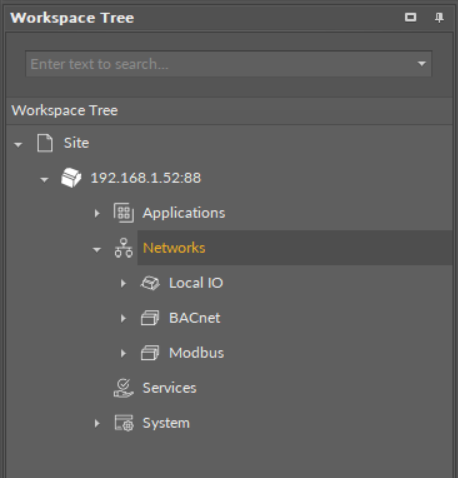The basic idea for the Networks container is to group all components that manage external communications of the device. The Networks container includes components that allow the device to transfer the HVAC automation data needed for the device to communicate externally. These components cover the fundamental layer of HVAC data transmission and are crucial for the device to be able to properly exchange information. The network point class components are located in the Networks container; both data transmission from the network points and controlling them in the application is achieved by the Reference linking, which is a linking method recommended over linking input and output slots directly, as the standard linking method misses the advantage of transferring the status info.

The Networks container
The components in the Networks container are meant to coordinate the external communications of the device: for example, the LocalIO manages the physical inputs and outputs, and the BACnet or Modbus coordinate the exposition to the BACnet or Modbus network.
Remember - No Licensed Elements in the Networks
The Networks container does not include any elements subject to licensing in the nano EDGE ENGINE devices. Network points are excluded from the licensing scheme, only Data Points are subject to license:
The license for the new generation of iSMA CONTROLLI controllers driven by the nano EDGE ENGINE is constructed against the number of Data Points: each device based on the nano EDGE ENGINE is granted a specified number of license points (Data Points in this case), which can be used within applications. Therefore, the licensing system is only of quantitative, not functional, character–only the real number of Data Points in applications is taken into account, regardless of how many communication protocols are used to expose them, or how many network points are controlled. With the nano EDGE ENGINE-generation devices it is possible to create as big an application (or applications) as the number of licensed Data Points. No elements in the Networks, Services, or System containers are subject to license limitations, other than Data Points in the Applications container.
Note: In order to check the number of license points, please refer to the License in the device.
Remember - Reference Linking
The Reference link is a special compound link designed to connect Data Points with network points. The Reference link is created between special Reference slots and transfers values along with the component's status. Alternatively, it may transfer values between Data Points and network points at the same time returning status from network points to Data Points, or it may return values from network points to Data Points. As network points are situated in the Networks container and Data Points are situated in the Applications container, Reference links are created using the Link Mark and Link From options from the context menu, and they are created between the tabs (or, for example, between the Application tab and the network points expanded in the Workspace Tree window). Either way the Reference link between tabs is displayed in the Wire Sheet as a bubble connected to the component's Reference slot.
